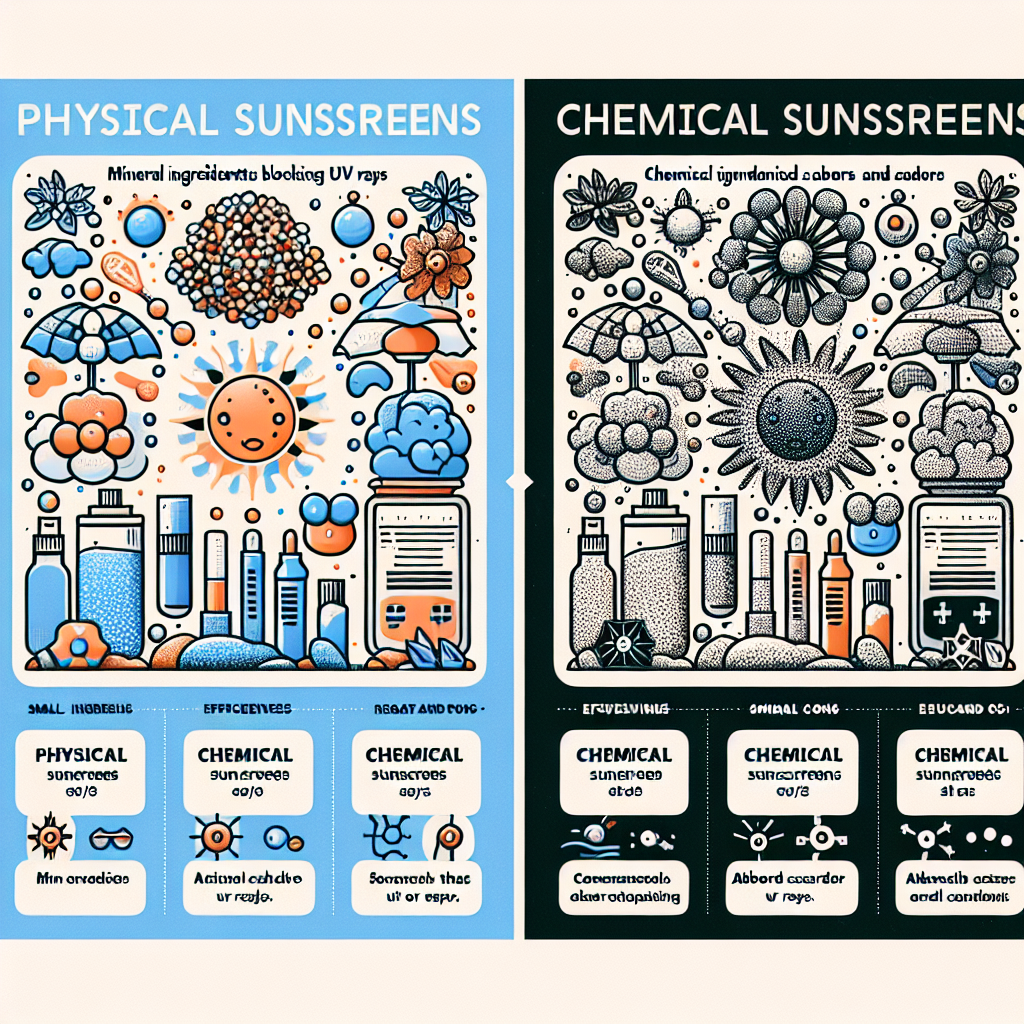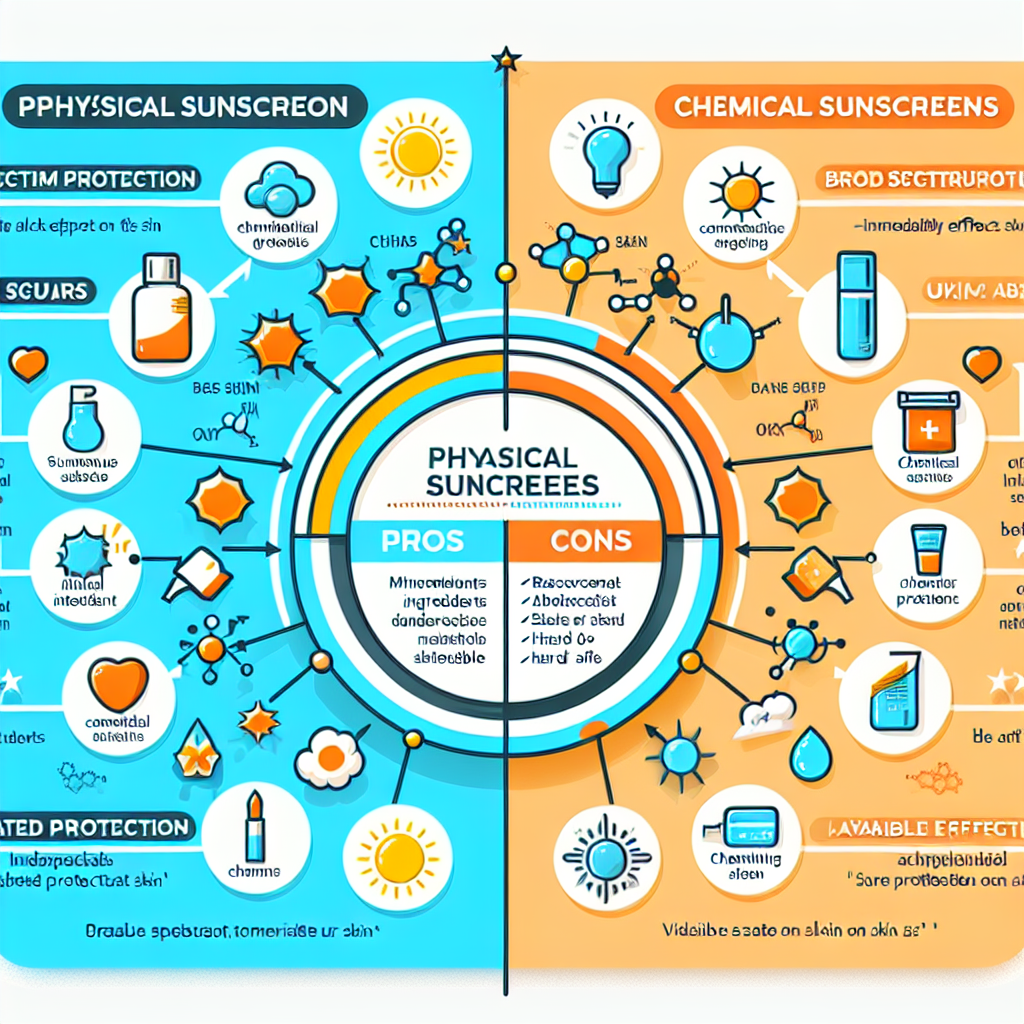Today, we’re going to shed some light on a topic that’s been buzzing in the beauty and skincare world – the difference between physical and chemical sunscreen. We all know the importance of protecting our skin from harmful sun rays, but when it comes to choosing the right sunscreen, things can get a little confusing. So, let’s break it down for you in a friendly and simple way. Physical sunscreen acts as a shield by reflecting and scattering the sun’s rays, while chemical sunscreens work by absorbing and neutralizing the harmful UV radiation. Now, let’s explore the pros and cons of each type and help you make an informed decision for your sun protection needs.
Physical Sunscreen
Physical sunscreen works by forming a protective barrier on the surface of your skin that reflects and scatters harmful UV rays away from your skin. The active ingredients in physical sunscreen are mineral-based, such as zinc oxide or titanium dioxide. These ingredients sit on top of your skin and act as a physical shield, blocking both UVA and UVB rays.
Ingredients
The main ingredients in physical sunscreen are zinc oxide and titanium dioxide. These minerals are naturally occurring and are less likely to cause skin irritation or allergies compared to chemical sunscreen ingredients. Physical sunscreen also often contains additional ingredients like botanical extracts and antioxidants, which provide additional nourishment and protection for your skin.
Mechanism of Action
Physical sunscreen works by reflecting and scattering UV rays away from your skin. This is achieved through the use of zinc oxide and titanium dioxide, which form a protective barrier on the skin’s surface. When UV rays hit this barrier, they are bounced off and prevented from penetrating into the deeper layers of your skin.
Protection
Physical sunscreen provides broad-spectrum protection, meaning it protects against both UVA and UVB rays. It is effective in blocking around 97% of UVB rays, which are primarily responsible for sunburns. However, physical sunscreen is not as effective in blocking UVA rays, which are associated with photoaging and skin cancer.
Effectiveness
Physical sunscreen is effective as soon as it is applied to the skin, making it ideal for immediate sun protection. However, it can be easily rubbed off or washed away by sweat or water, so it may require more frequent reapplications, especially when engaging in water activities or outdoor sports.
Suitability for Different Skin Types
Physical sunscreen is generally well-tolerated and suitable for all skin types, including sensitive and acne-prone skin. Since it sits on top of the skin, it does not clog pores or cause breakouts. This makes it a great option for those with oily or acne-prone skin. The natural and mineral-based ingredients also make it less likely to cause skin irritation or allergies.
Chemical Sunscreen
Chemical sunscreen works by absorbing UV rays and converting them into heat, which is then released from the skin. The active ingredients in chemical sunscreen are organic compounds, such as avobenzone, octinoxate, or oxybenzone. These ingredients penetrate the skin and work by absorbing UV radiation.
Ingredients
Chemical sunscreen contains organic compounds as its active ingredients. Common chemical sunscreen ingredients include avobenzone, octinoxate, oxybenzone, and homosalate. Some chemical sunscreens may also contain additional ingredients, such as moisturizers or antioxidants, to provide extra benefits for the skin.
Mechanism of Action
Chemical sunscreen absorbs UV radiation when applied to the skin. The organic compounds in the sunscreen convert the UV rays into heat, which is then released from the skin. This mechanism allows chemical sunscreen to protect the skin from the harmful effects of both UVA and UVB rays.
Protection
Chemical sunscreen provides broad-spectrum protection against UVA and UVB rays. It is effective in absorbing and neutralizing UV rays, preventing them from damaging the skin. However, it is worth noting that some chemical sunscreen ingredients, such as oxybenzone, have raised concerns regarding their potential hormonal effects and impact on the environment.
Effectiveness
Chemical sunscreen takes approximately 20 minutes to be fully effective after application. It needs to be absorbed into the skin for it to start working. Once absorbed, chemical sunscreen provides effective protection against the sun’s rays. However, it may not be as immediately effective as physical sunscreen.
Suitability for Different Skin Types
Chemical sunscreen is generally suitable for all skin types. However, some individuals with sensitive or reactive skin may experience irritation or allergies to certain chemical sunscreen ingredients. It is important to patch test new chemical sunscreen products on a small area of skin before applying it all over your face or body.

Choosing the Right Sunscreen
When it comes to choosing the right sunscreen for your needs, there are several factors to consider. Here are some important considerations to keep in mind:
Considerations
- Skin type: Consider your skin type and any specific concerns you may have, such as sensitivity or acne-prone skin.
- Allergies: If you have known allergies to certain ingredients, make sure to check the ingredient list of the sunscreen.
- Personal preferences: Consider factors such as scent, texture, and finish when choosing a sunscreen that you will enjoy using.
Sun Protection Factor (SPF)
The Sun Protection Factor (SPF) measures the level of protection a sunscreen provides against UVB rays. The higher the SPF, the more protection it offers. For daily use, a broad-spectrum sunscreen with an SPF of 30 or higher is recommended. However, it’s important to note that SPF only indicates protection against UVB rays and not UVA rays.
Texture and Application
Consider the texture and application of the sunscreen. Some sunscreens may have a thick or greasy texture, which can be uncomfortable for those with oily or acne-prone skin. Look for sunscreens that are lightweight, fast-absorbing, and leave a non-greasy finish.
Sensitivity and Allergies
If you have sensitive or reactive skin, it’s essential to choose a sunscreen that is formulated for sensitive skin or labeled as hypoallergenic. Look for sunscreens that are fragrance-free and free from common irritants, such as parabens or sulfates. Patch testing new sunscreens on a small area of skin can also help identify any potential reactions.
Environmental Factors
Consider your environment and the activities you’ll be engaging in while wearing sunscreen. If you plan on swimming or participating in water sports, choose a water-resistant sunscreen. If you’ll be spending extended periods of time outdoors, consider a sunscreen with added antioxidant ingredients to provide extra protection against environmental damage.
Application of Sunscreen
Proper application of sunscreen is crucial to ensure its effectiveness. Here are some important factors to keep in mind:
Amount
Apply a sufficient amount of sunscreen to adequately cover all exposed areas of skin. The generally recommended amount is approximately a teaspoon for the face and a shot glass-sized amount for the body. Applying less than the recommended amount can significantly reduce the level of protection provided.
Frequency
Reapply sunscreen every 2 hours or more frequently if sweating or swimming. Even if the sunscreen claims to be water-resistant, it can still rub off or become diluted with water, reducing its effectiveness. Reapplication is especially important during prolonged sun exposure.
Areas of Application
Don’t forget to apply sunscreen to commonly overlooked areas, such as the ears, back of the neck, and hands. Lips are also susceptible to sun damage, so consider using a lip balm with SPF protection.
Sunscreen and Makeup
If you wear makeup, choose a sunscreen that can be easily layered under your products. Look for lightweight formulas that won’t interfere with the application or finish of your makeup. Alternatively, consider using a tinted sunscreen that can replace your foundation for a natural look.
Tips for Proper Application
- Apply sunscreen at least 15 minutes before sun exposure to allow it to fully absorb into the skin.
- Pay attention to areas that often get overlooked, such as the hairline and scalp.
- Consider using a sunscreen with a pump or spray nozzle for easy and convenient application.

Potential Side Effects
While sunscreens are generally safe to use for most individuals, there are potential side effects to be aware of. These can vary depending on the type of sunscreen and individual sensitivities.
Physical Sunscreen
Physical sunscreen is less likely to cause skin irritation or allergic reactions compared to chemical sunscreen. However, in some rare cases, individuals with extremely sensitive skin may experience irritation or redness when using physical sunscreen.
Chemical Sunscreen
Some individuals may experience skin irritation or allergies when using chemical sunscreen. This is more common in people with sensitive or reactive skin. Additionally, certain chemical sunscreen ingredients, such as oxybenzone, have raised concerns about their potential hormonal effects. It’s always important to read and understand the ingredient list before using any sunscreen product.
Skin Irritation
Both physical and chemical sunscreens can cause skin irritation in some individuals. This can manifest as redness, itching, or a rash. If you experience any skin irritation after applying sunscreen, it is recommended to discontinue use and consult with a dermatologist.
Allergic Reactions
Certain individuals may have allergies to specific sunscreen ingredients. Common allergens include fragrances, preservatives, and chemical UV filters. Patch testing new sunscreen products on a small area of skin can help identify any potential allergies before applying it all over your face or body.
Environmental Impact
Chemical sunscreens can have a negative impact on the environment, particularly when used in coral reef ecosystems. Certain chemical UV filters, like oxybenzone and octinoxate, have been found to damage coral reefs and contribute to coral bleaching. To minimize environmental impact, consider choosing sunscreens labeled as “reef-safe” or using physical sunscreens.
Suitability for Different Activities
Different activities may require different types of sunscreen for maximum effectiveness. Here’s a breakdown of the suitability of physical and chemical sunscreens for various activities:
Water Activities
For water activities such as swimming or snorkeling, it is important to use a water-resistant sunscreen to ensure the protection remains intact even when in contact with water. Both physical and chemical sunscreens are available in water-resistant formulations.
Outdoor Sports
If you engage in outdoor sports that involve sweating or prolonged sun exposure, a water-resistant sunscreen is recommended. Physical sunscreens may require more frequent reapplication due to their tendency to rub off or be washed away by sweat.
Everyday Use
For daily use, both physical and chemical sunscreens are suitable options. Consider your skin type, preferences, and the level of protection required when choosing a sunscreen for everyday use. Look for a broad-spectrum sunscreen with an SPF of 30 or higher.
High Altitude
At high altitudes, the intensity of UV rays increases. Therefore, it is crucial to use a sunscreen with a higher SPF and broad-spectrum protection. Both physical and chemical sunscreens can provide the necessary protection at high altitudes.
Tropical Climate
In tropical climates where the sun is intense and humidity is high, water-resistant sunscreens are recommended. Look for lightweight formulas that won’t feel heavy or greasy on the skin. Physical and chemical sunscreen options are both suitable, depending on personal preferences and skin sensitivities.

Longevity and Persistence
The longevity and persistence of sunscreen play a significant role in its effectiveness. Here’s what you need to know about the durability of physical and chemical sunscreens:
Physical Sunscreen
Physical sunscreen provides immediate protection upon application, as it forms a physical barrier on the skin. However, it can be easily rubbed off or washed away by sweat or water, making it necessary to reapply more frequently, especially during water activities.
Chemical Sunscreen
Chemical sunscreen takes approximately 20 minutes to be fully effective after application, as it needs to be absorbed into the skin. Once absorbed, chemical sunscreen provides long-lasting protection. However, like physical sunscreen, it can still rub off or become diluted with water, requiring reapplication.
Water Resistance
Both physical and chemical sunscreens are available in water-resistant formulations. Water-resistant sunscreens offer increased protection during water activities and sweating. However, it’s important to note that water resistance does not mean the sunscreen is waterproof, and reapplication is necessary after prolonged water exposure.
Reapplication
Regardless of the type of sunscreen you use, reapplication is essential for maintaining effective sun protection. It is recommended to reapply sunscreen every 2 hours or more frequently if sweating or swimming. This helps to replenish the protective layer of sunscreen that may have rubbed off or been diluted.
Duration of Protection
The duration of sunscreen protection varies depending on factors such as sun exposure, sweat, and water contact. While both physical and chemical sunscreens offer protection, regular reapplication is necessary to ensure continuous and effective protection throughout the day.
Myths and Misconceptions
There are several myths and misconceptions surrounding sunscreen. It’s important to separate fact from fiction to make informed decisions about sun protection. Let’s debunk some of the common myths:
Physical Sunscreens Block All Sunlight
Contrary to popular belief, physical sunscreens do not block all sunlight. While they provide effective protection against both UVA and UVB rays, they do not offer complete blockage. It is still essential to seek shade, wear protective clothing, and limit sun exposure, especially during peak sun hours.
Chemical Sunscreens are Harmful
There have been concerns raised about the safety of certain chemical sunscreen ingredients, such as oxybenzone. However, the majority of chemical sunscreen ingredients are considered safe and FDA-approved for use in sunscreens. It’s important to choose sunscreen products from reputable brands and read and understand the ingredient list.
Natural Sunscreens are Better
Natural sunscreens, also known as mineral sunscreens, refer to physical sunscreens that use mineral-based ingredients. While they are a popular choice for those seeking natural options, it’s important to note that not all natural ingredients provide adequate sun protection. The most important factor in choosing a sunscreen is its ability to provide broad-spectrum protection and its proper application.
Sunscreen Use Leads to Vitamin D Deficiency
While sunscreen does help protect against harmful UV rays, it does not completely block out all sunlight. When wearing sunscreen, your skin can still produce vitamin D when exposed to sunlight. However, it’s always a good idea to ensure you are getting an adequate amount of vitamin D through diet or supplementation.
Sunscreen is Only Required on Sunny Days
UV rays are present even on cloudy or overcast days. Up to 80% of UV rays can penetrate through clouds, which means you are still at risk of sun damage. It is essential to wear sunscreen daily, regardless of the weather or time of year, to protect your skin from the harmful effects of UV radiation.

Innovations in Sunscreen Technology
Sunscreen technology continues to evolve, with new innovations aimed at improving the efficacy and user experience. Here are some notable advancements in sunscreen:
Nanoparticles
Nanoparticles are tiny particles that are commonly used in physical sunscreens to enhance their application and appearance. These miniature particles help reduce the white cast often associated with physical sunscreens, making them more appealing to users.
Broad-Spectrum Protection
Advancements in sunscreen formulations have led to the development of sunscreens that provide broad-spectrum protection against both UVA and UVB rays. These sunscreens offer comprehensive defense against sun damage, reducing the risk of sunburns, premature aging, and skin cancer.
Cosmetic Formulations
Sunscreen formulations have become more advanced, with lightweight and non-greasy options available. Many sunscreens now double as primers for makeup, offering a smooth base for foundation application while providing sun protection.
Hybrid Sunscreens
Hybrid sunscreens combine the benefits of physical and chemical sunscreens. These sunscreens often contain a combination of mineral and chemical filters to provide broad-spectrum protection while offering an appealing texture and finish.
Eco-Friendly Sunscreens
With growing concerns about the environmental impact of certain sunscreen ingredients, there has been an increase in the availability of eco-friendly sunscreens. These sunscreens use biodegradable or reef-safe ingredients to minimize harm to marine ecosystems.
Conclusion
Sunscreen plays a vital role in protecting our skin from the harmful effects of the sun’s UV rays. Physical and chemical sunscreens each have their unique characteristics, benefits, and considerations. When choosing a sunscreen, consider factors such as your skin type, preferences, and the activities you’ll be engaging in. Remember to apply sunscreen generously, reapply regularly, and wear protective clothing and seek shade whenever possible. With the wide variety of sunscreens available today, finding the right sunscreen for your needs and lifestyle is easier than ever. Stay sun-safe and enjoy the outdoors with proper sun protection.






